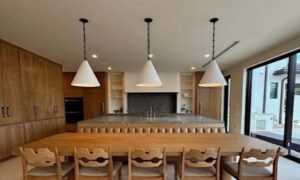Step into the dazzling world of 3D animation, where creativity knows no bounds and imagination takes flight. From breathtaking landscapes to lifelike characters, the key to bringing these digital creations to life lies in mastering lighting and texturing techniques. In this blog post, we’ll explore how these two crucial elements work together to create stunningly realistic visuals that will captivate audiences worldwide. So grab your virtual paintbrush and let’s dive into the exciting realm of 3D animation!
Introduction to 3D Animation and its Importance in Today’s Media World
In today’s media world, 3D animation has become an essential tool for creating visually appealing and engaging content. From blockbuster movies to video games and commercials, the use of 3D animation has revolutionized the way stories are told and visuals are presented.
But what exactly is 3D animation? In simple terms, it is a process of manipulating digital objects in a three-dimensional space to create lifelike motion. Unlike traditional 2D animation, which only allows for movements on a flat surface, 3D animation enables artists to bring their ideas to life in a more realistic and immersive manner.
Understanding the Role of Lighting and Texturing in Creating Realistic Animations
Lighting and texturing are two of the most crucial elements in creating realistic 3D animations. They go hand in hand to breathe life into a virtual world, making it feel believable and immersive for the audience. Without proper lighting and texturing, even the most detailed models and animations can fall flat.
The role of lighting in animation is more than just illuminating a scene. It sets the mood, defines the atmosphere, and emphasizes important elements in the scene. Just like in photography or filmmaking, good lighting can make or break an animation.
In 3D animation, there are three main types of lights: ambient, directional, and point lights. Ambient light provides overall illumination to a scene without any directionality. Directional light mimics sunlight or moonlight by casting shadows and giving objects depth. Point lights act as spotlights, highlighting specific areas or objects.
A skilled animator must know how to manipulate these different types of light to create the desired effect in their animation. For example, if you want to create a dramatic or mysterious atmosphere, using low-key lighting with strong directional light sources can achieve that effect. On the other hand, if you want a bright and cheerful scene, using soft ambient light can help create that feeling.
Textures play an equally important role as they add visual interest and realism to an object or environment. Textures are images that are wrapped around 3D models to mimic real-world surfaces like wood grain, fabric weave, or skin texture.
There are two main techniques for applying textures: UV mapping and procedural textures. UV mapping involves “unwrapping” a 3D model onto a flat surface (like peeling an orange) so that an image texture can be applied precisely on top of it. Procedural textures use mathematical algorithms to generate textures based on parameters set by the animator.
Mastering both techniques is essential for creating nuanced details in your animations – wrinkles on a character’s clothing, the roughness of a rock surface, or the imperfections on an object. Not only do textures add realism to an animation, but they also help with lighting. The way light reacts to different types of surfaces can be enhanced with appropriate texturing, making objects appear more realistic.
Key Concepts of Lighting: Shadows, Colors, and Ambient Occlusion
Lighting is a crucial aspect in the world of 3D animation. It not only adds realism to the virtual world but also has the power to evoke emotions and convey a story. To master lighting in your 3D animations, it is important to have a good understanding of key concepts such as shadows, colors, and ambient occlusion.
Shadows play a vital role in creating depth and dimension in an animated scene. They are created when light rays are blocked by objects, resulting in less light reaching certain areas. The intensity, direction, and softness of shadows depend on factors such as the position and size of the light source, the distance between the light source and object, and the shape of the object casting the shadow.
In 3D animation, there are different types of shadows that can be used to create different effects. Hard shadows have sharp edges and are typically produced by small or distant light sources. On the other hand, soft shadows have blurred edges and are created by larger or closer light sources.
Color is another essential element that can greatly impact how an animated scene is perceived by viewers. Colors not only add visual interest but also help to establish mood and atmosphere. When working with colors in 3D animation lighting setups, it is important to consider color theory principles such as complementary colors (colors opposite each other on the color wheel), which can produce visually striking contrasts.
Another critical concept related to lighting in 3D animation is ambient occlusion (AO). This technique simulates how light gets trapped between objects or crevices without being completely absorbed or reflected. It creates subtle darkening around edges or concave surfaces where natural light would struggle to reach.
Ambient occlusion adds depth and texture to scenes making them look more realistic. It helps define shapes and provides visual clues for spatial relationships between objects within a scene. This technique can be controlled by adjusting its intensity, distance, and falloff to achieve the desired effect.
Mastering Texturing Techniques: UV Mapping, Materials, and Texture Painting
One of the most crucial aspects of creating realistic 3D animation is mastering texturing techniques. It involves giving objects and characters their distinct appearance by applying textures, materials, and colors to them.
The first step in this process is UV mapping, which stands for “texture coordinates.” In simple terms, it involves flattening out the surface of a 3D model into a two-dimensional space so that textures can be applied accurately. This step is essential because it determines how well the textures will wrap around the object, ultimately affecting its final appearance. There are several methods for UV mapping, including automatic projections and manual editing, each with its own advantages and disadvantages.
Once the UV mapping is done, it’s time to move on to materials. Materials are what make an object look like wood, metal, glass or any other material. They add depth and realism to 3D models by simulating light interaction with different surfaces. Materials can be created using various properties such as color, roughness, reflectivity, transparency and more. These properties can also be combined in layers to achieve even more detailed results.
Texture painting is another crucial aspect of texturing that allows artists to give objects a specific look or feel. Texture painting involves adding textures directly onto a model’s surface rather than through traditional image files used for UV mapping. This technique allows for greater control over how textures are applied to add more detail and realism to an object’s surface.
The key to mastering texture painting lies in understanding how light interacts with different surfaces in real life. For example, wood has visible grain patterns that affect how light reflects off its surface compared to smooth plastic or shiny metal.
Additionally, paying attention to details such as color variation within certain materials can greatly enhance the realism of a 3D model. For instance, when creating wooden furniture pieces like tables or chairs; adding subtle variations of brown tones can make it appear more lifelike than a flat, single-color surface.
Tools for Achieving Realistic Lighting and Texturing: Software, Plugins, and Hardware
1. Software:
Choosing the right software is vital when it comes to achieving realistic lighting and texturing. Some of the most popular software used by professionals include Autodesk Maya, Blender, and Cinema 4D. These programs have advanced features that allow users to control every aspect of lighting and texture in their scenes.
Maya, for example, offers a wide range of advanced tools such as Arnold Renderer which provides physically-based rendering for accurate lighting simulation. It also has a variety of shader options for creating lifelike textures on objects.
Blender is another powerful program that is popular among beginners due to its user-friendly interface. It has an extensive library of free add-ons like Cycles Renderer which allows for easy manipulation of light sources within a scene.
Cinema 4D is known for its efficient workflow and intuitive UI. Its Physical Render engine enables users to create photorealistic images with ease while its material system offers precise control over textures, reflections, bump maps, etc.
2. Plugins:
Plugins are additional pieces of software that can be added onto existing programs to enhance their capabilities further. They offer extended functionality and specialized features that can greatly improve the quality of your animations.
One such plugin is Substance Painter which allows artists to paint high-quality textures directly onto their models in real-time with incredible detail and customization options.
Another useful plugin is Redshift Render which uses GPU acceleration for fast rendering speeds while producing high-quality results with physically-based materials and volumetric effects.
3. Hardware:
While having powerful software is essential, utilizing appropriate hardware is equally important when working on complex 3D animations with realistic lighting and texturing.
Having a high-performance graphics card is crucial for rendering detailed textures and handling intricate light simulations. Investing in a powerful processor and sufficient RAM can also improve overall performance.
Moreover, having multiple monitors can contribute to better workflow efficiency by providing more screen real estate for multitasking while working on complex scenes.
Tips and Tricks for Controlling Light and Texture to Enhance the Quality of Your
Controlling light and texture is an important aspect of creating a realistic 3D animation. Proper lighting can make or break the final look of an animation, while textures add depth and detail to objects within the scene. In this section, we will discuss some useful tips and tricks for mastering these techniques to enhance the quality of your 3D animation.
1. Understanding Lighting Techniques:
The first step to controlling light in a 3D animation is understanding the different lighting techniques available. The most commonly used techniques are global illumination, ambient occlusion, and specular highlights. Global illumination mimics the way light bounces off surfaces, creating a more natural and realistic look. Ambient occlusion adds shadows to areas where objects meet or overlap, adding depth and definition to the scene. Specular highlights replicate how light reflects off shiny surfaces, making them appear more glossy and polished.
2. Use Reference Images:
Before beginning any project, it’s essential to gather reference images that showcase proper lighting and textures within a similar setting or environment as your animation. These images can serve as inspiration when setting up lights and choosing textures for your scene.
3. Utilize Different Light Sources:
To create a dynamic effect in your scene, consider using multiple light sources instead of relying on one overhead light source. This technique helps create more depth by casting shadows from different angles in the scene.
4 . Experiment with Color Temperature:
Color temperature refers to whether a source of light appears warm (orange) or cool (blue). By adjusting color temperature in your scene, you can evoke different emotions or moods within your audience.
5 . Consider Light Falloff:
In real life, objects appear darker as they move away from their primary light source due to diminishing intensity known as “light falloff.” By adjusting this in your 3D software settings, you can achieve more realistic lighting results.
6 . Add Textures for Detail:
Textures are essential elements that add detail and depth to your objects. Utilize high-quality images for textures that are relevant to your scene and adjust their placement, size, and orientation to create a realistic effect.
7 . Choose Textures That Complement Each Other:
When choosing textures for different objects in your scene, make sure they complement each other. For instance, the texture of a fabric should be different from that of metal or glass.
Conclusion
As we have explored, mastering lighting and texturing techniques is crucial for creating realistic 3D animations. By understanding the principles of light and how it interacts with surfaces, as well as using advanced texturing methods, animators can bring their creations to life in a way that captivates audiences. With continued advancements in technology, the possibilities are endless for creating truly dynamic and lifelike animated films and video games. So whether you’re an aspiring animator or simply appreciate the art of animation, mastering these key techniques will take your work to new heights.



































